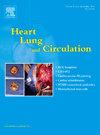亚重度和重度急性肺栓塞采用侵入性和非侵入性疗法后的长期超声心动图和临床疗效。
IF 2.2
4区 医学
Q2 CARDIAC & CARDIOVASCULAR SYSTEMS
引用次数: 0
摘要
目的:急性肺栓塞(PE)是导致住院患者死亡的重要原因。本研究旨在概述大面积和亚大面积肺栓塞患者接受手术和非手术治疗后的长期疗效:人群队列观察研究:评估 5 年内(2013-2018 年)在西澳大利亚州三家三级医院接受心胸科治疗的所有患者。研究人员查阅了所有患者的病历、放射学资料、相关死亡率数据以及基层医院所有可用的超声心动图检查资料:共发现 245 名患者,其中 41 人接受了手术治疗,204 人接受了非手术治疗;人口统计学数据相似。临床上,手术组患者在介入治疗前出现休克、需要使用血管加压药、严重心动过缓或心肺复苏的比例较高。手术栓子切除术组(2/41 [4.2%])和非手术组(17/201 [8.3%])的 28 天死亡率在统计学上无显著差异(P=0.382)。12个月的死亡率没有差异,包括根据血管加压剂、右心室应变、肌钙蛋白和脑钠肽进行调整后的结果。在大面积 PE 分组中,28 天死亡率无显著差异:手术组 2/29(6.9%)vs 非手术组 7/34(20.2%)(P=0.064)。手术组出现严重 RV 损伤和扩张的比例更高。所有在门诊随访时接受超声心动图检查的患者均恢复正常或轻度RV受损:结论:大面积或亚大面积肺栓塞患者无论接受手术治疗还是非手术治疗,结果都相似。在心胸中心,手术栓子切除术是一种安全的选择。本文章由计算机程序翻译,如有差异,请以英文原文为准。
Long-Term Echocardiographic and Clinical Outcomes After Invasive and Non-Invasive Therapies for Sub-Massive and Massive Acute Pulmonary Embolism
Aim
Acute pulmonary embolism (PE) is a significant cause of mortality in the hospital setting. The objective of this study was to outline the long-term outcomes after surgical and non-surgical management for patients with massive and submassive PE.
Methods
Population cohort observational study evaluating all patients who presented to three tertiary hospitals in the state of Western Australia with access to cardiothoracic services over 5 years (2013–2018). Reviewed notes of all patients as well as radiology, linked mortality data and all available echocardiography studies at the primary hospital.
Results
In total, 245 patients were identified, of which 41 received surgical management and 204 non-surgical management; demographic data was similar. Clinically, the surgical group had higher rates of shock requiring vasopressors, severe bradycardia, or cardiopulmonary resuscitation prior to intervention. The 28-day mortality was not statistically significantly different between the surgical embolectomy group (2/41 [4.2%]) and the non-surgical group (17/201 [8.3%]) (p=0.382). There was no difference in 12-month mortality, including when this was adjusted for vasopressors, right ventricular (RV) strain, troponin, and brain natriuretic peptide. In the massive PE sub-group, 28-day mortality was not significantly different: 2/29 (6.9%) surgical group vs 7/34 (20.2%) non-surgical group (p=0.064). Higher rates of severe RV impairment and dilatation were present in the surgical group. All patients with available echocardiography studies at outpatient follow-up returned to normal or mild RV impairment.
Conclusion
Patients who presented with massive or submassive PE had similar outcomes whether treated with surgical or non-surgical management. Surgical embolectomy is a safe option in a cardiothoracic centre setting.
求助全文
通过发布文献求助,成功后即可免费获取论文全文。
去求助
来源期刊

Heart, Lung and Circulation
CARDIAC & CARDIOVASCULAR SYSTEMS-
CiteScore
4.50
自引率
3.80%
发文量
912
审稿时长
11.9 weeks
期刊介绍:
Heart, Lung and Circulation publishes articles integrating clinical and research activities in the fields of basic cardiovascular science, clinical cardiology and cardiac surgery, with a focus on emerging issues in cardiovascular disease. The journal promotes multidisciplinary dialogue between cardiologists, cardiothoracic surgeons, cardio-pulmonary physicians and cardiovascular scientists.
 求助内容:
求助内容: 应助结果提醒方式:
应助结果提醒方式:


